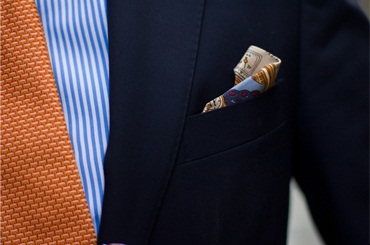If you want to turn out like the gentleman shown here (and let’s face it, who doesn’t?) without breaking the bank on Savile Row, here are five good tips when looking for an off-the-rack suit on the high street.

1. Sacks are for potatoes – not well dressed men
There are many measurements to consider when finding a suit jacket that fits, but you must make sure you concentrate on these three at the very least: the chest, the waist, and the shoulders.
Given the way in which suit jackets are sized – that is to say, chest size-by-length – even the most clueless buyer will be fleetingly aware that the chest is an important area. Amazing, then, that so many still get it wrong. It’s quite simple, really: make sure your lapels lay against your chest when the jacket is buttoned, not too tight, but certainly with no gaping space.
Similarly, the way your jacket fits around your waist is paramount. Getting this measurement right can be the difference between looking like a true flâneur of Naples and a miserly bouncer on the doorstep of a grim nightclub in Stoke.
Italian suits are world-renowned, so let’s look to pasta for inspiration: A poorly-fitted jacket will make you look square, creating parallel lines of your torso – think ravioli. What you really want is to be closer to farfalle (that’s the bow shape to you and I) – pinched at the waist, with the correct amount of suppression to emphasise the broadness of your shoulders. This may take some alteration (which can be done at a modest cost) but be warned: go too tight and the fabric will pull at the button when fastened, creating a stretched look.
Speaking of shoulders, this is the third key measurement to consider. Too wide and your jacket will slump half way down your deltoids, creating a divot where the arms meets the shoulder pad; too narrow and the fabric will gather and look unsightly across your shoulder blades. Aim for a smooth transition between the corner of the shoulder and the sleeve.
2. Avoid a short jacket like the plague
I’ve noticed that a lot of high street suits come with disproportionately short jackets. Of course, if you’re on the short side, you will take a short jacket, but proportion is key: the sleeves should never be as long as the jacket itself; heaven forbid they are longer.
But the latter is not as uncommon as you might think. Frankly, it’s a disastrous look, creating a pear shape where one does not exist, often accentuating the backside and thighs of even the slimmest gentleman.
Opt instead for a jacket that covers your backside fully – this will usually leave at least three inches between the bottom of your sleeve (which should fall no lower than your wrist bone) and the bottom of the jacket. Critically, this will make you look slimmer and taller – and that’s good news for all of us.
3. The 80s have been and gone. Get your leg tailored
Off-the-rack needn’t mean you have to look like MC Hammer in parachute pants. Not being able to afford bespoke tailoring is one thing; shunning alteration is just negligent. And cheap.
Length is important: never have more than a single break in the front crease; you can forget having one at all at the back. I appreciate not everyone likes to pair their suits with penny loafers and bare ankles, but neither should the bottom of your trousers resemble accordions.
Tapering is also key. A lot of modern high street stores, particularly those aimed at younger men, are guilty of ‘over-skinnifying’ their suit trousers. Look elsewhere; nobody wants to see your package, and the skin-tight-around-the-thigh look is best left to to cyclists.
Instead, get your trousers tapered so that they mimic the shape of your leg closely, but never quite hug. Pay special attention to the ankle area: too little tapering and you’ll have excessive movement when you walk; too much and you’ll sail perilously close to carrot territory.
4. Less is more. To paraphrase Cary Grant, let them see you, not the suit
The temptation when buying a suit is to get as much bang for your buck as possible. I’m talking fancy, bordered lapels, bright and brilliant buttons, and stand-out print.
The truth is, these can look cheap when done on a budget. Bold fabrics might look great when done by Gieves & Hawkes, not so much when your suit costs less than a tenth of the price.
Simplicity is key. Subtle, textured fabrics, in classic colours work best. Make sure the lapel style isn’t too thin. And forget gimmicks like black edging around pockets.
If you pride yourself on eccentricity, make up for it with your tie and pocket square. But as far as the suit goes, take Cary Grant’s advice.
5. You’ve got your suit – don’t fall at the last hurdle
Ok. You’ve got your suit. It fits well. You opted against that bold plaid print. Don’t mess it up now with a cheap, skinny tie, or clumpy shoes.
Accessories are key to looking good in a suit. Shoes arguably most of all. Don’t scrimp and save – you’ll end up going through three or four pairs of poorly made shoes when you could have forked out a bit extra for a quality pair that will last. If Church’s are out of your price range, drop down a tier and try Loake – their 747 Oxfords are value for money at £145.00.

Ties and pocket squares are where you can fully express yourself. An advantage of having a plain suit is that you can opt for bold patterned ties and wild pocket squares, but don’t match the two – it’s a dated look. Try contrasting colours. Just be careful not to resemble a bad acid trip.
Why not consider a bespoke shirt? They’re not as expensive as you might think and will help to maintain the clean-line look. Finicky shirts, for example, offer a bespoke product for as little as £64.95.
And finally, avoid belts if you can. A belt looks great with a sports jackets and chinos, but they’re not for suits. They interrupt the flow and add lumps and bumps where they shouldn’t.


